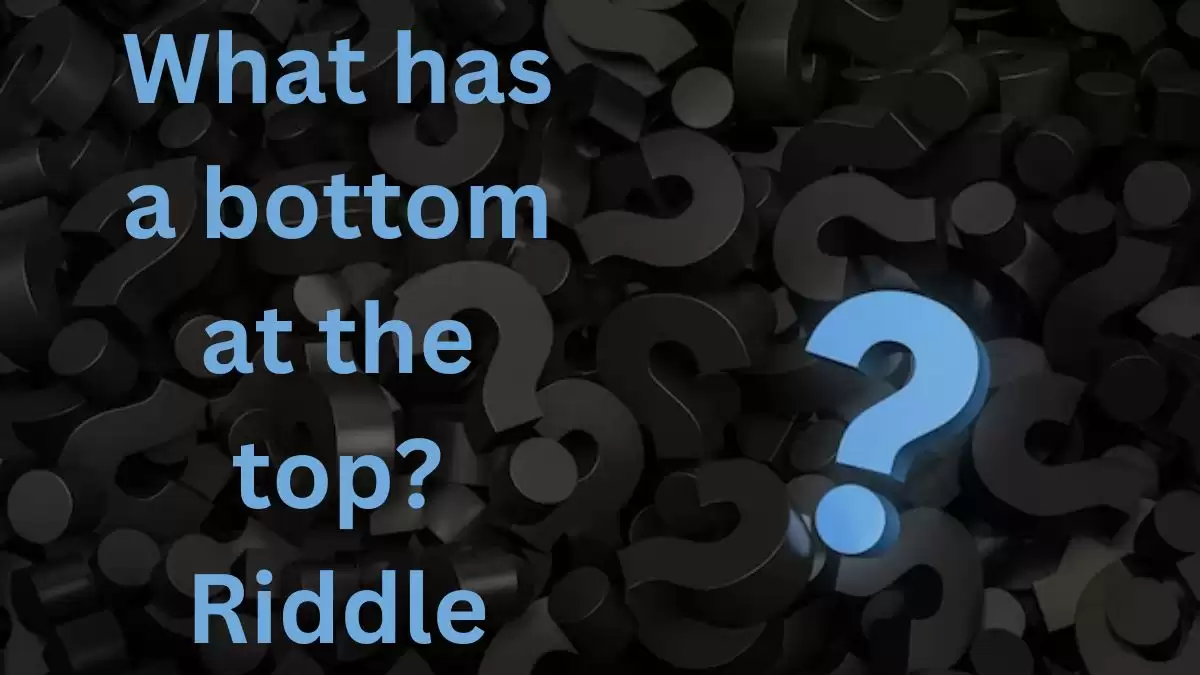What has a bottom at the top? Riddle Answer Solved and Explained
by Mathelene
Updated Nov 15, 2023

What has a bottom at the top? Riddle
This riddle playfully challenges your perception with a clever twist. Imagine an object that, despite its typical orientation, has a "bottom" located at the top. The wording prompts you to consider a familiar item from an unconventional perspective, encouraging creative thinking. This riddle is designed to engage your imagination and sense of humor, urging you to think beyond the ordinary.
It taps into the fun of linguistic play and the joy of discovering unexpected connections. By prompting you to visualize an everyday object in a new way, it highlights the importance of approaching problems with an open mind and embracing unconventional viewpoints. In essence, this riddle is a playful exercise that demonstrates how language and perspective can be used to challenge and expand our thinking.
Riddles in our page extends beyond the ordinary, offering you intricate puzzles that stimulate your intellect and provide hours of amusement. At Fresherslive you can get amazed with these riddles.
What has a bottom at the top? Riddle Answer
Answer : leg / legs.
Explanation
The riddle's answer, "leg" or "legs," cleverly challenges the expected orientation of body parts. Typically, when we think of legs, we envision them at the bottom of the body. However, the riddle introduces a whimsical twist by suggesting that a leg has its "bottom" at the top, creating a playful linguistic paradox.
This wordplay encourages the audience to rethink their assumptions and consider alternative perspectives. The riddle serves as a lighthearted reminder that language and perception are flexible, and our interpretations can be influenced by how we frame a question. In unraveling the answer, individuals engage in a mental exercise that promotes creativity and a willingness to view familiar things in new and unconventional ways, making the riddle both amusing and thought-provoking.
What is Riddle?
Get ready for an exciting journey into the world of riddles! Riddles are like puzzles that use clever words and tricky meanings to challenge our thinking. They have been enjoyed for a very long time, and they make our brains work hard. Imagine a place where riddles are like kings. They twist and turn with tricky words, making us scratch our heads. Some riddles are very old, passed down for generations, while others are brand new and designed to make us think.
As we go on this riddle adventure, get ready to use your imagination and brainpower. Riddles are not just simple questions. They make us think hard and find smart answers. Each time you solve a riddle, it's like a big win, showing how clever you are. Even when a riddle is too tough to crack, it leaves us wondering and wanting to learn more.
So, let's enjoy riddles together. They will make you curious, imaginative, and smarter. We'll uncover your brilliance one riddle at a time and have fun along the way!
Advantages Of Solving Riddles
Thinking Skills: Riddles make you think hard, improving your ability to solve tricky problems and come up with creative ideas.
Problem Solving: They challenge you to find unique solutions, teaching you to look at things from different angles and solve complex issues.
Language Skills: Riddles are like word puzzles. They help you learn new words and understand how language works, making you better at talking and writing.
Creativity: Riddles encourage you to think outside the box, which means thinking in new and creative ways. This skill can be useful in many areas of life.
Mental Exercise: Solving riddles is like a workout for your brain. It keeps your mind active, improves your memory, and helps you focus better.
What has a bottom at the top? Riddle - FAQs
The riddle's answer is "leg" or "legs."
This riddle playfully challenges your perception by asking about an object with a bottom at the top, prompting creative thinking.
The riddle encourages individuals to rethink assumptions and consider alternative perspectives, fostering creativity and mental flexibility.
The linguistic paradox adds a whimsical element, prompting a fresh perspective on familiar concepts and showcasing the flexibility of language and perception.
The wordplay challenges conventional thinking, urging individuals to see familiar objects in new and unconventional ways, promoting creativity.







